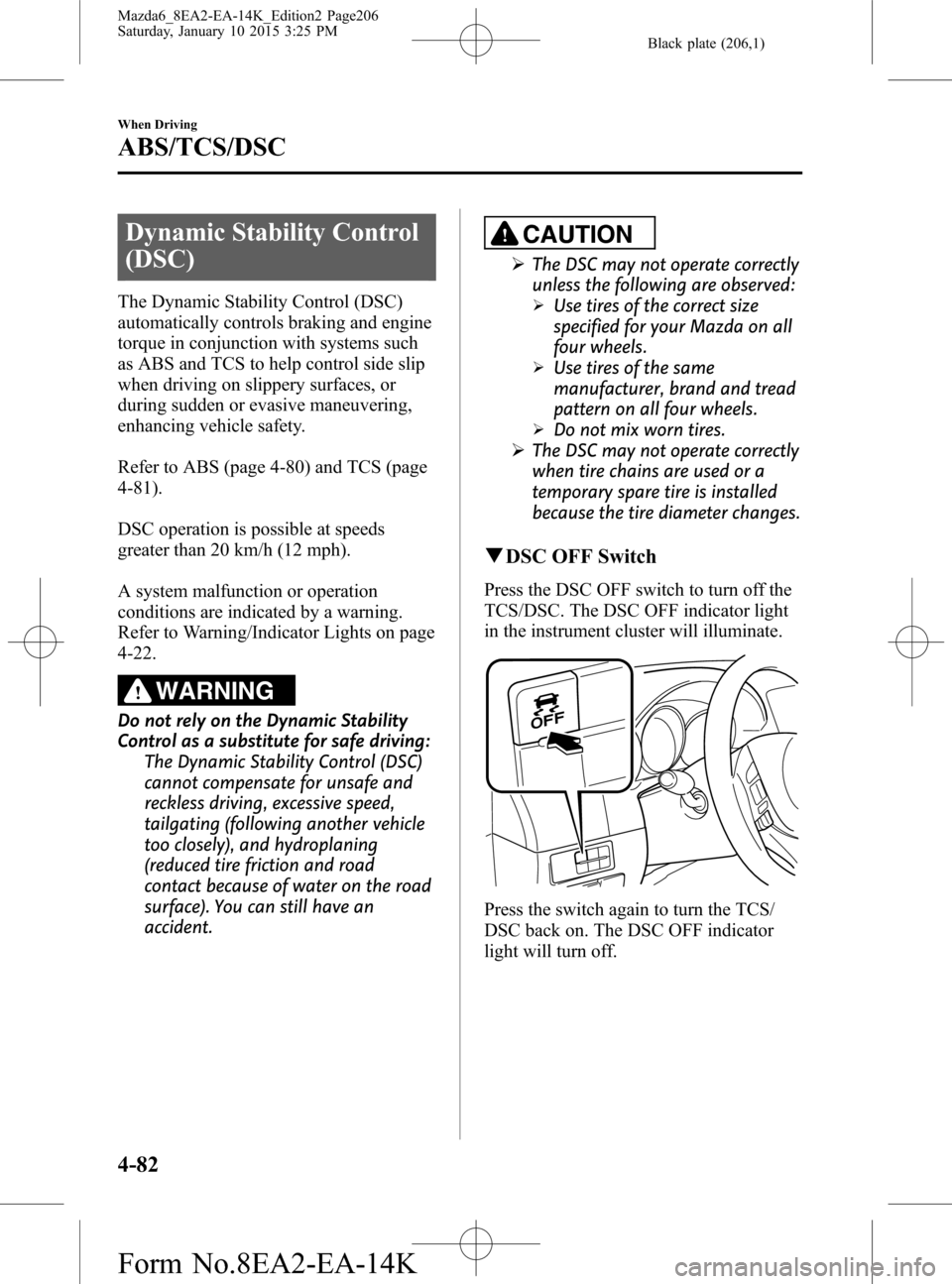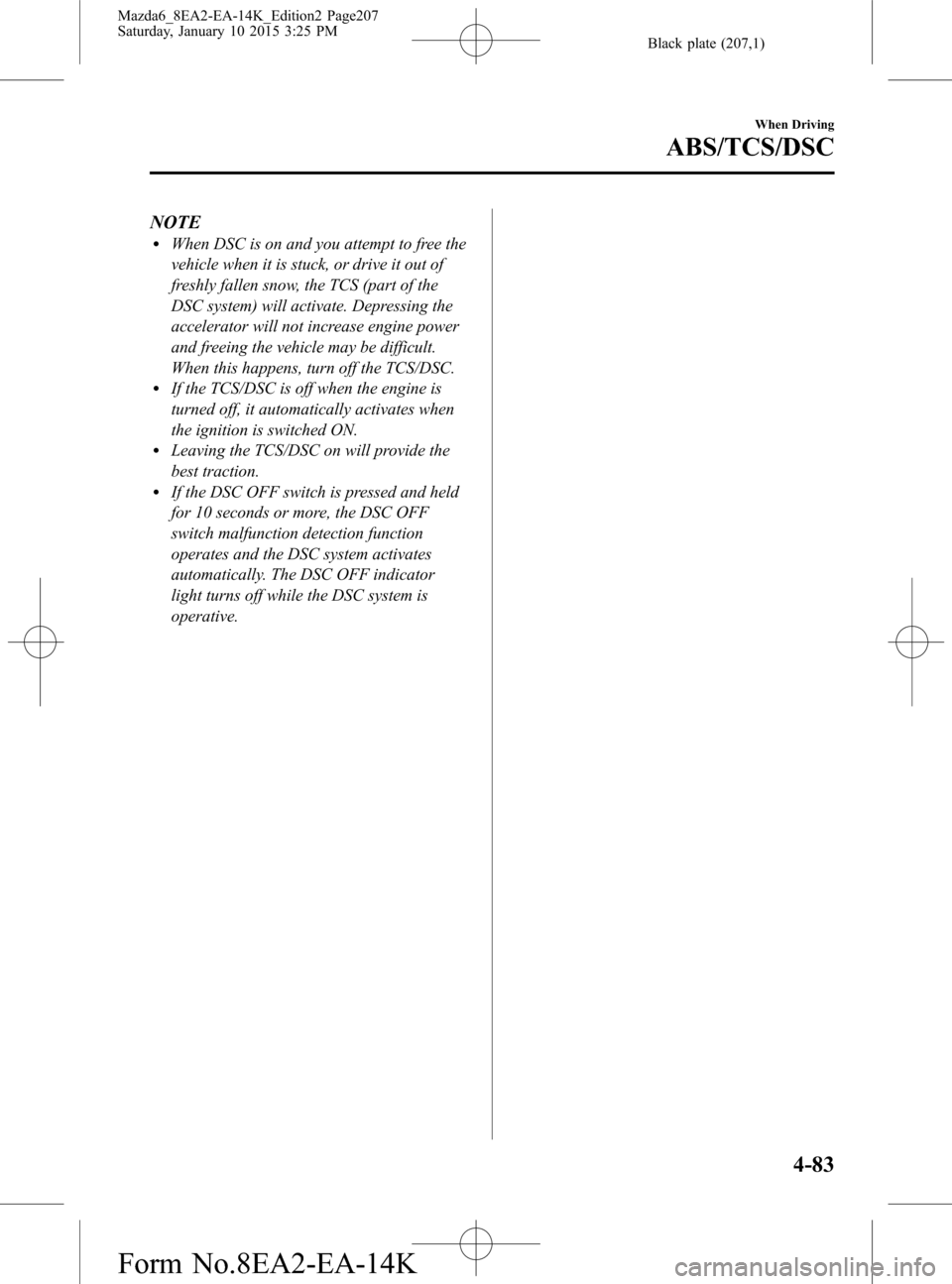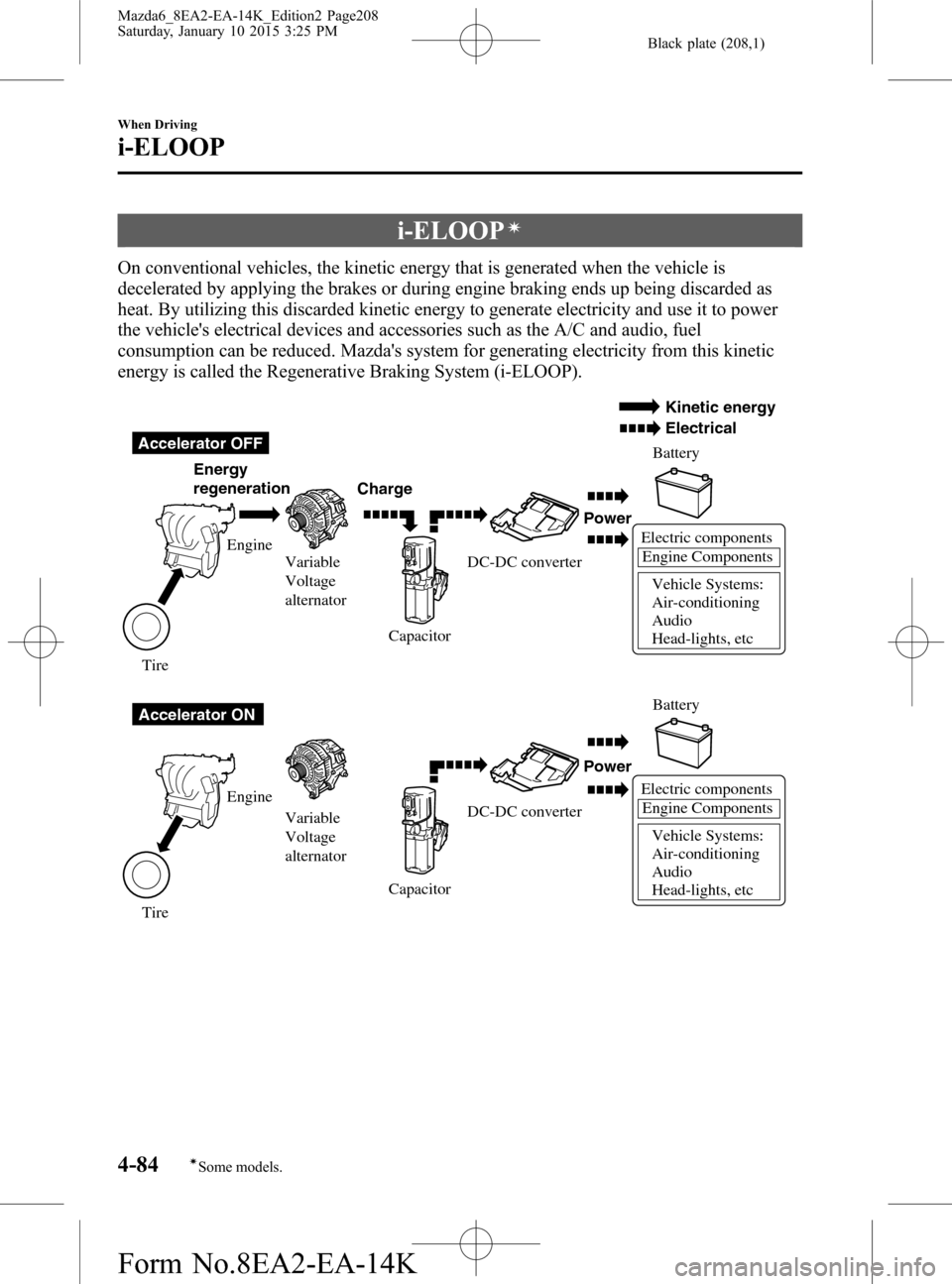engine MAZDA MODEL 6 2016 (in English) Repair Manual
[x] Cancel search | Manufacturer: MAZDA, Model Year: 2016, Model line: MODEL 6, Model: MAZDA MODEL 6 2016Pages: 614, PDF Size: 12.82 MB
Page 191 of 614

Black plate (191,1)
ØWhen the wiper lever is in the
AUTO position and the ignition is
switched ON, the wipers may
move automatically in the
following cases:
ØIf the windshield above the rain
sensor is touched or wiped with
a cloth.
ØIf the windshield is struck with
a hand or other object from
either outside or inside the
vehicle.
Keep hands and scrapers clear of
the windshield when the wiper
lever is in the AUTO position and
the ignition is switched ON as
fingers could be pinched or the
wipers and wiper blades damaged
when the wipers activate
automatically.
If you are going to clean the
windshield, be sure the wipers are
turned off completely―this is
particularly important when
clearing ice and snow―when it is
most likely that the engine is left
running.NOTE
lSwitching the auto-wiper lever from the
to theposition while driving
activates the windshield wipers once, after
which they operate according to the rainfall
amount.
lThe auto-wiper control may not operate
when the rain sensor temperature is about
_
10 °C or lower, or about 85 °C or higher.
lIf the windshield is coated with water
repellent, the rain sensor may not be able to
sense the amount of rainfall correctly and
auto-wiper control may not operate
properly.
lIf dirt or foreign matter (Such as ice or
matter containing salt water) adheres to the
windshield above the rain sensor or if the
windshield is iced, it could cause the wipers
to move automatically. However, if the
wipers cannot remove this ice, dirt or
foreign matter, the auto-wiper control will
stop operation. In this case, set the wiper
lever to the low speed position or high
speed position for manual operation, or
remove the ice, dirt or foreign matter by
hand to restore the auto-wiper operation.
lIf the auto-wiper lever is left in the
position, the wipers could operate
automatically from the effect of strong light
sources, electromagnetic waves, or infrared
light because the rain sensor uses an
optical sensor. It is recommended that the
auto-wiper lever be switched to the
position other than when driving the vehicle
under rainy conditions.
lThe auto-wiper control functions can be
turned off.
Refer to Personalization Features on page
9-9.
When Driving
Switches and Controls
4-67
Mazda6_8EA2-EA-14K_Edition2 Page191
Saturday, January 10 2015 3:25 PM
Form No.8EA2-EA-14K
Page 198 of 614

Black plate (198,1)
Brake System
qFoot Brake
Your Mazda has power-assisted brakes
that adjust automatically through normal
use.
Should power-assist fail, you can stop by
applying greater force than normal to the
brake pedal. But the distance required to
stop will be greater than usual.
WARNING
Do not coast with the engine stalled or
turned off, find a safe place to stop:
Coasting with the engine stalled or
turned off is dangerous. Braking will
require more effort, and the brake's
power-assist could be depleted if you
pump the brake. This will cause
longer stopping distances or even an
accident.
Shift to a lower gear when going down
steep hills:
Driving with your foot continuously
on the brake pedal or steadily
applying the brakes for long
distances is dangerous. This causes
overheated brakes, resulting in
longer stopping distances or even
total brake failure. This could cause
loss of vehicle control and a serious
accident. Avoid continuous
application of the brakes.
Dry off brakes that have become wet
by driving slowly, releasing the
accelerator pedal and lightly applying
the brakes several times until the brake
performance returns to normal:
Driving with wet brakes is
dangerous. Increased stopping
distance or the vehicle pulling to one
side when braking could result in a
serious accident. Light braking will
indicate whether the brakes have
been affected.
4-74
When Driving
Brake
Mazda6_8EA2-EA-14K_Edition2 Page198
Saturday, January 10 2015 3:25 PM
Form No.8EA2-EA-14K
Page 200 of 614

Black plate (200,1)
NOTElThe electric parking brake cannot be
applied or released while the vehicle
battery is dead.
lAn operation sound occurs when applying
or releasing the electric parking brake,
however, this does not indicate a
malfunction.
lIf the electric parking brake is not used for
long periods, an automatic inspection of the
system is performed while the vehicle is
parked. An operation sound can be heard,
however, this does not indicate a problem.
lWhen the electric parking brake is applied
and the ignition is switched OFF, an
operation sound can be heard, however,
this does not indicate a problem.
lThe brake pedal may move while the
electric parking brake is being applied or
released, however, this does not indicate a
problem.
lIf the electric parking brake switch is
continually pulled while driving the vehicle,
the electric parking brake will be applied
and the electric parking brake warning
beep will be activated. When the switch is
released, the electric parking brake is
released and the beep stops.
lIf the electric parking brake is applied with
the ignition switched off or in ACC, the
brake system warning light in the
instrument cluster and the indicator light in
the switch may turn on for 15 seconds.
lWhen running the vehicle through an
automatic car wash, it may be necessary to
switch the ignition off with the parking
brake released depending on the type of
automatic car wash.
When applying the electric parking
brake
The electric parking brake can be applied
regardless of the ignition switch position.
Securely depress the brake pedal and pull
up the electric parking brake switch.
The electric parking brake is applied and
the brake system warning light and the
electric parking brake switch indicator
light turn on.
Refer to Warning/Indicator Lights on page
4-22.
When releasing the electric parking
brake
The electric parking brake can be released
while the ignition is switched ON or the
engine is running. When the electric
parking brake is released, the brake
system warning light and the electric
parking brake switch indicator light turn
off.
4-76
When Driving
Brake
Mazda6_8EA2-EA-14K_Edition2 Page200
Saturday, January 10 2015 3:25 PM
Form No.8EA2-EA-14K
Page 201 of 614

Black plate (201,1)
Electric parking brake manual release
Securely depress the brake pedal and
press the electric parking brake switch.
Electric parking brake automatic
release
If the accelerator pedal is depressed with
the electric parking brake applied and all
of the following conditions met, the
parking brake is released automatically.
lThe engine is running.lThe driver's door is closed.lThe driver's seat belt is fastened.
(Manual transaxle)
lThe change lever is in a position other
than neutral.
lThe clutch pedal is depressed halfway
(Automatic transaxle)
lSelector lever is in the D, M, or R
position
NOTE
If something such as the driver's foot contacts
the accelerator pedal with the engine running
and the electric parking brake applied, the
parking brake may be released automatically.
If you do not intend to drive immediately, shift
the change lever (manual transmission) to the
neutral position, or shift the selector lever
(automatic transmission) to the P or N
position.
qDisplay Indication
For vehicles with the type A instrument
cluster, check the vehicle condition or
have the vehicle inspected at an
Authorized Mazda Dealer according to
the indication.
qWarning Light
A system malfunction or operation
conditions are indicated by a warning.
Refer to Warning/Indicator Lights on page
4-22.
qBrake Pad Wear Indicator
When the disc brake pads become worn,
the built-in wear indicators contact the
disc plates. This causes a screeching noise
to warn that the pads should be replaced.
When you hear this noise, consult an
Authorized Mazda Dealer as soon as
possible.
WARNING
Do not drive with worn disc pads:
Driving with worn disc pads is
dangerous. The brakes could fail and
cause a serious accident. As soon as
you hear a screeching noise consult
an Authorized Mazda Dealer.
When Driving
Brake
4-77
Mazda6_8EA2-EA-14K_Edition2 Page201
Saturday, January 10 2015 3:25 PM
Form No.8EA2-EA-14K
Page 204 of 614

Black plate (204,1)
Antilock Brake System (ABS)
The ABS control unit continuously
monitors the speed of each wheel. If one
wheel is about to lock up, the ABS
responds by automatically releasing and
reapplying that wheel's brake.
The driver will feel a slight vibration in
the brake pedal and may hear a chattering
noise from the brake system. This is
normal ABS system operation. Continue
to depress the brake pedal without
pumping the brakes.
A system malfunction or operation
conditions are indicated by a warning.
Refer to Warning/Indicator Lights on page
4-22.
WARNING
Do not rely on ABS as a substitute for
safe driving:
The ABS cannot compensate for
unsafe and reckless driving, excessive
speed, tailgating (following another
vehicle too closely), driving on ice and
snow, and hydroplaning (reduced tire
friction and road contact because of
water on the road surface). You can
still have an accident.NOTE
lBraking distances may be longer on loose
surfaces (snow or gravel, for example)
which usually have a hard foundation. A
vehicle with a normal braking system may
require less distance to stop under these
conditions because the tires will build up a
wedge of surface layer when the wheels
skid.
lThe sound of the ABS operating may be
heard when starting the engine or
immediately after starting the vehicle,
however, it does not indicate a malfunction.
4-80
When Driving
ABS/TCS/DSC
Mazda6_8EA2-EA-14K_Edition2 Page204
Saturday, January 10 2015 3:25 PM
Form No.8EA2-EA-14K
Page 205 of 614

Black plate (205,1)
Traction Control System
(TCS)
The Traction Control System (TCS)
enhances traction and safety by
controlling engine torque and braking.
When the TCS detects driving wheel
slippage, it lowers engine torque and
operates the brakes to prevent loss of
traction.
This means that on a slick surface, the
engine adjusts automatically to provide
optimum power to the drive wheels,
limiting wheel spin and loss of traction.
A system malfunction or operation
conditions are indicated by a warning.
Refer to Warning/Indicator Lights on page
4-22.
WARNING
Do not rely on the Traction Control
System (TCS) as a substitute for safe
driving:
The Traction Control System (TCS)
cannot compensate for unsafe and
reckless driving, excessive speed,
tailgating (following another vehicle
too closely), and hydroplaning
(reduced tire friction and road
contact because of water on the road
surface). You can still have an
accident.
Use snow tires or tire chains and drive
at reduced speeds when roads are
covered with ice and/or snow:
Driving without proper traction
devices on snow and/or ice-covered
roads is dangerous. The Traction
Control System (TCS) alone cannot
provide adequate traction and you
could still have an accident.
NOTE
To turn off the TCS, press the DSC OFF switch
(page 4-82).
When Driving
ABS/TCS/DSC
4-81
Mazda6_8EA2-EA-14K_Edition2 Page205
Saturday, January 10 2015 3:25 PM
Form No.8EA2-EA-14K
Page 206 of 614

Black plate (206,1)
Dynamic Stability Control
(DSC)
The Dynamic Stability Control (DSC)
automatically controls braking and engine
torque in conjunction with systems such
as ABS and TCS to help control side slip
when driving on slippery surfaces, or
during sudden or evasive maneuvering,
enhancing vehicle safety.
Refer to ABS (page 4-80) and TCS (page
4-81).
DSC operation is possible at speeds
greater than 20 km/h (12 mph).
A system malfunction or operation
conditions are indicated by a warning.
Refer to Warning/Indicator Lights on page
4-22.
WARNING
Do not rely on the Dynamic Stability
Control as a substitute for safe driving:
The Dynamic Stability Control (DSC)
cannot compensate for unsafe and
reckless driving, excessive speed,
tailgating (following another vehicle
too closely), and hydroplaning
(reduced tire friction and road
contact because of water on the road
surface). You can still have an
accident.
CAUTION
ØThe DSC may not operate correctly
unless the following are observed:
ØUse tires of the correct size
specified for your Mazda on all
four wheels.
ØUse tires of the same
manufacturer, brand and tread
pattern on all four wheels.
ØDo not mix worn tires.
ØThe DSC may not operate correctly
when tire chains are used or a
temporary spare tire is installed
because the tire diameter changes.
qDSC OFF Switch
Press the DSC OFF switch to turn off the
TCS/DSC. The DSC OFF indicator light
in the instrument cluster will illuminate.
Press the switch again to turn the TCS/
DSC back on. The DSC OFF indicator
light will turn off.
4-82
When Driving
ABS/TCS/DSC
Mazda6_8EA2-EA-14K_Edition2 Page206
Saturday, January 10 2015 3:25 PM
Form No.8EA2-EA-14K
Page 207 of 614

Black plate (207,1)
NOTElWhen DSC is on and you attempt to free the
vehicle when it is stuck, or drive it out of
freshly fallen snow, the TCS (part of the
DSC system) will activate. Depressing the
accelerator will not increase engine power
and freeing the vehicle may be difficult.
When this happens, turn off the TCS/DSC.
lIf the TCS/DSC is off when the engine is
turned off, it automatically activates when
the ignition is switched ON.
lLeaving the TCS/DSC on will provide the
best traction.
lIf the DSC OFF switch is pressed and held
for 10 seconds or more, the DSC OFF
switch malfunction detection function
operates and the DSC system activates
automatically. The DSC OFF indicator
light turns off while the DSC system is
operative.
When Driving
ABS/TCS/DSC
4-83
Mazda6_8EA2-EA-14K_Edition2 Page207
Saturday, January 10 2015 3:25 PM
Form No.8EA2-EA-14K
Page 208 of 614

Black plate (208,1)
i-ELOOPí
On conventional vehicles, the kinetic energy that is generated when the vehicle is
decelerated by applying the brakes or during engine braking ends up being discarded as
heat. By utilizing this discarded kinetic energy to generate electricity and use it to power
the vehicle's electrical devices and accessories such as the A/C and audio, fuel
consumption can be reduced. Mazda's system for generating electricity from this kinetic
energy is called the Regenerative Braking System (i-ELOOP).
Electric components
Engine Components
Vehicle Systems:
Air-conditioning
Audio
Head-lights, etc
Accelerator OFF
Accelerator ONEnergy
regeneration
ChargeBattery
Battery Power
Power
Electric components
Engine Components
Vehicle Systems:
Air-conditioning
Audio
Head-lights, etc
Engine
Variable
Voltage
alternator
Variable
Voltage
alternator Engine
Tire TireCapacitor
CapacitorDC-DC converter
DC-DC converter
Kinetic energy
Electrical
4-84
When Driving
íSome models.
i-ELOOP
Mazda6_8EA2-EA-14K_Edition2 Page208
Saturday, January 10 2015 3:25 PM
Form No.8EA2-EA-14K
Page 210 of 614

Black plate (210,1)
qi-ELOOP Charging Display
If the engine is started after the vehicle
has not been driven for a long period of
time, an“i-ELOOP charging”message
may be indicated in the display.
Leave the engine idling and wait until the
message disappears.
NOTE
If the vehicle is driven while the message is
displayed, a beep sound is heard.
If you turn the steering wheel while the
message is displayed, it will feel heavier than
normal, but this does not indicate an
abnormality. Stop the vehicle in a safe location
with the engine running and do not attempt to
turn the steering wheel. The steering operation
will return to normal after the message is no
longer displayed.
4-86
When Driving
i-ELOOP
Mazda6_8EA2-EA-14K_Edition2 Page210
Saturday, January 10 2015 3:25 PM
Form No.8EA2-EA-14K